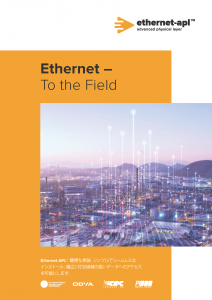Specification downloads
- “Ethernet-APL Port Profile Specification”, v1.0
- “Ethernet-APL EMC Test Specification”, v1.0
- “Ethernet-APL Engineering Guideline”, v.1.0
Ethernet-APL media insert (English / German) for Achema-Pulse June 15/16, 2021
Download English brochure here Download German brochure here
Ethernet-APL brochure (English / Japanese)
Download English brochure here Download Japanese brochure here
Abstract
Process plants operate for 20+ years and are required to be safe for people, the product,
and the environment. Explosion potential in hazardous areas and harsh conditions require
that any deployment of new technology is both thoroughly tested and provides added
business benefits. Technology must not be complicated in handling or require extensive
training. Ethernet is the de-facto communication standard in enterprises, but it does not
meet the requirements in the field of process automation without modification.
Ethernet with an Advanced Physical Layer (Ethernet-APL) will enable long cable lengths
and explosion protection via intrinsic safety with communication and power over two wires.
Based on IEEE and IEC standards, Ethernet-APL supports any Ethernet-based automation
protocol and will develop into a single, long-term stable technology for the entire process
automation community. This white paper covers the business environment, technical specifications,
implications for different user types, and the development status of Ethernet-APL.
Situation and Business Environment for Process Applications
Process plants today compete to produce more products with less waste, and thin profit
margins require increased output yield with increasing quality. Digital transformation has
made it increasingly worthwhile for companies to consider making investments to obtain
more plant data from process automation systems and instrumentation. However, to do so,
new procedures and products are required to gain access to this data from every part of
the plant and to extract more value on every production run.
In the manufacturing industries, the Industrial Internet of Things (IIoT) and Industrie 4.0 are
already part of everyday operations, and in the near future, these technologies will also
enter the field of process automation and instrumentation. In the process industries, domainspecific
concepts like the NAMUR Open Architecture (NOA) or the Open Process Automation
Standards (O-PAS™) by the Open Process Automation Forum (OPAF) are presently
attempting to simplify the efficient construction, commissioning, and operation of process
plants. Broader use of wireless solutions, simplified field device integration, and Ethernet to
the field represent integral components of these concepts.
Leading suppliers to process automation recognize the need from their customers to add
the universality and communication speed of standard Ethernet to existing field device installations.
Ethernet has been deployed at the upper levels of the automation pyramid and
in the field with 4-wire Ethernet devices, such as drives, flow, analyzers and motor control
centers. However, it requires enhancements to support applications in the field of process
plants.
A key group of these leading suppliers and standards development organizations have come
together with the goal of accelerating development and adopting a new open standard for
an Ethernet physical layer for the use in process automation and instrumentation that can be
deployed in hazardous areas, allow long-reach connectivity, and include an option for device
power over the line. This new Ethernet advanced physical layer, called “Ethernet-APL,”
together with the automation protocols that define the structure and meaning of information
being transmitted to and from field devices, will be one of the key enabling factors of the
IIoT in process automation. It will provide a vital prerequisite to extend the digitized world to
process automation and instrumentation.
This paper describes the standardization and development of Ethernet-APL: a single, ruggedized
and reliable physical layer with attributes that meet the requirements for the field of
process plants. Ethernet-APL enables a logical extension of Ethernet-based communications
from enterprise systems to the field. This last meter of Ethernet connectivity would allow any
enterprise boardroom to obtain data from all regions of its extensive network.
Organization of the Cooperation
The agreement to develop the Ethernet-APL technology under “The APL Project” was established
in 2018 and is backed by the leading industry standard development organizations
(SDOs) FieldComm Group, ODVA, OPC Foundation, and PROFIBUS & PROFINET International,
as well as by major industry suppliers of process automation, including ABB, Emerson,
Endress+Hauser, Krohne, Pepperl+Fuchs, Phoenix Contact, R. Stahl, Rockwell Automation,
Samson, Siemens, Vega, and Yokogawa.
OPC Foundation joint Ethernet-APL consortia in 2020.
More Information:
Contact
- Chairperson Ethernet-APL consortium:
Dr. Jörg Hähniche, joerg.haehniche@endress.com
. - Representative from OPC Foundation
Stefan Hoppe, stefan.hoppe@opcfoundation.org
Peter Lutz, peter.lutz@opcfoundation.org






